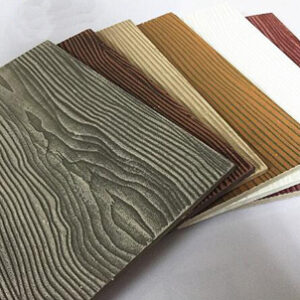
The main advantages of our Wooden Texture Fiber Cement Siding over real wood are concentrated in Performance, Durability, and Maintenance. Our product provides the classic, authentic look of wood without the inherent structural weaknesses and high upkeep costs of natural timber.
Here is a breakdown of the key advantages:
Superior Durability & Resistance
| Feature | Wooden Texture Fiber Cement Siding | Real Wood Siding |
| Moisture & Rot | Highly resistant to water damage. It will not swell, rot, or decay, making it ideal for high-humidity or coastal climates. | Prone to absorbing moisture, which leads to rotting, warping, and cracking over time, requiring costly repairs. |
| Pest Damage | Termite and insect proof because it is a cement-based material. It provides no food source for pests. | Highly susceptible to termite, carpenter ant, and woodpecker damage, which can compromise structural integrity. |
| Fire Safety | Non-combustible and has a Class A fire rating (best possible). It will not ignite when exposed to a direct flame. | Combustible. It acts as fuel for a fire, posing a significant safety risk, especially in wildfire-prone areas. |
| Dimensional Stability | Offers excellent dimensional stability (low deformation coefficient). It resists warping, buckling, and shrinking due to temperature and humidity shifts. | Subject to swelling and shrinking with changes in weather, which can lead to paint peeling and structural movement. |
Low Maintenance & Long-Term Value
| Feature | Wooden Texture Fiber Cement Siding | Real Wood Siding |
| Maintenance Needs | Very low maintenance. Requires only periodic cleaning (usually with a hose) and repainting is typically only needed every 10-15 years. | Requires frequent and demanding maintenance, including repainting, staining, or sealing every 3-7 years to prevent decay. |
| Color Longevity | Our pre-finished planks (e.g., with a factory-applied baked-on finish) are designed to resist UV fading, chipping, and peeling for a long lifespan. | Colors naturally fade, weather, and often chalk over time, necessitating regular re-application of protective coatings. |
| Life-Cycle Cost | Higher initial cost, but its exceptional longevity (50+ years) and minimal maintenance requirements result in a lower total cost of ownership (LCO) over the building’s lifespan. | Lower initial cost, but the high recurring costs of maintenance, repairs, and replacement significantly increase the LCO over time. |
| Aesthetics | Provides the authentic, deep texture of natural wood grain (e.g., Cedar or Oak) with a perfectly consistent and stable finish. | Provides a natural look, but often features inconsistencies, knots, and blemishes, which can sometimes affect finish application. |
In summary, our product offers your clients the warm, classic beauty of wood combined with the performance and peace of mind of a highly engineered, modern building material.
14
OCT
2025
OCT
2025
0
